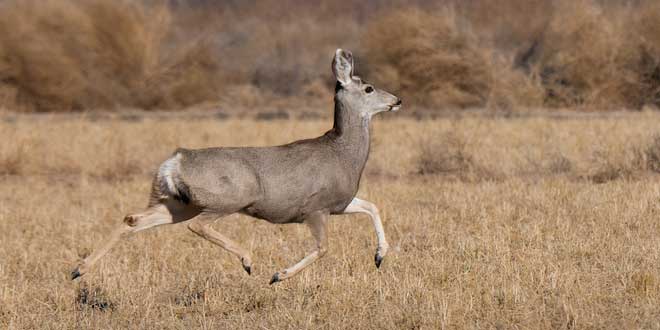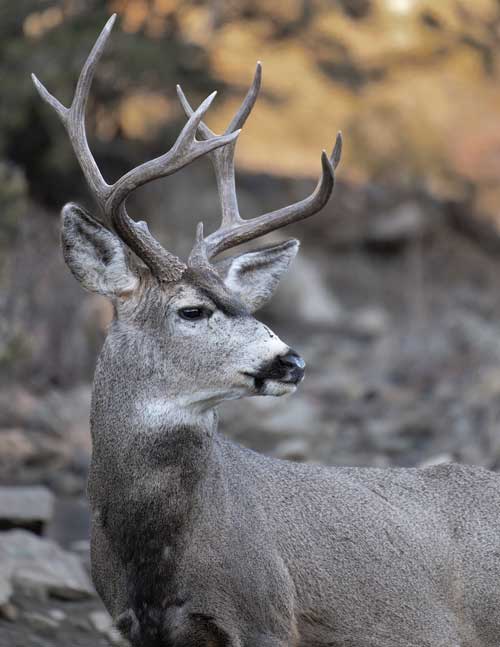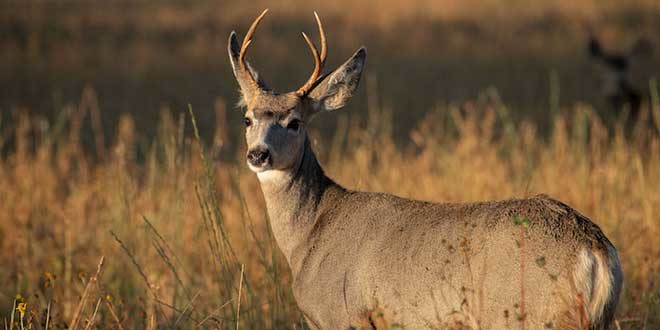Mule deer are perhaps the most widely distributed and best-known large mammal found in New Mexico. The state’s mule deer population includes two subspecies. The Rocky Mountain mule deer inhabits the northern half of the state, while desert mule deer are most abundant in the state’s southern half. New Mexico’s mule deer provide economic and social benefits, such as wildlife viewing, hunting opportunities and photography.
Mule deer food habits
Mule deer are considered browsers, preferring woody plants’ leaves, stems, and buds. Forbs (weeds and other herbaceous plants) also are a significant part of their diet during the spring and summer. Like most species of wildlife, mule deer are opportunistic. If they have the chance, they will feed on crops: corn, soybeans, small grains, alfalfa, fruit trees and vegetables.
Recognizing deer damage
Before you spend time and money controlling and preventing deer damage, it is important to determine if deer are responsible for the damage. Other wildlife, such as rabbits and rodents, should be considered as possible culprits. Because deer do not possess upper incisors, their browsing often leaves a jagged or torn surface on twigs or stems. Most rodents leave a clean-cut surface on the vegetation they are eating.
Deer tracks are distinctive, and the height at which deer browse often eliminates other wildlife, except for their close relative, elk. The size of elk tracks versus those of deer is a good method to differentiate between the two. Observing deer “in the act” of feeding on your property is the best method to identify the cause. Deer are most active in the evening and early morning hours when neighborhoods are generally the quietest.

Methods for prevention of mule deer damage
Private industry, and the professional wildlife biologists of the New Mexico Department of Game and Fish, developed several methods for dealing with nuisance urban deer herds. Several commercial repellents can be effective, although they work best when reapplied periodically, especially after rain or snow showers. Repellents may be found at most feed supply stores, or distributors can be located through a quick search of the internet.
Scare devices often are used to address nuisance deer problems. Several commercially available products employ motion sensors that emit amplified, ultrasonic bursts of sound when activated. Manufacturers say the frequency is inaudible to humans but stressful for deer. Most of these devices are designed to reset themselves after the deer have moved out of the area. These products may work in the short term, but deer may eventually become accustomed, causing these devices to lose effectiveness. Colorful flagging, draped across trails used by deer, presents a visual deterrent and should be used in conjunction with scare devices and repellents.
Many plants are resistant to deer browsing and should be selected where possible. Though some plants are resistant to damage, they can be less effective depending on the availability of natural browse. Local nurseries should be able to provide you with a list of plants and reference books that will help you in your selection. It is recommended that native plant species be selected wherever possible. These plants will be better adapted to local conditions than their exotic counterparts.

The most effective way to prevent deer from browsing on your property is to fence them out. There are a number of fence designs that have been proven both effective and humane. For most situations, installing one or two strands of electrified high-tensile wire on top of an existing fence is the simplest and most cost-effective design. The top wire should be placed at least 68 inches above the ground. Be sure to eliminate gaps greater than 8 inches between the existing fence and the top wire.
In places where fencing is impractical, wrapping individual plants and shrubs with sections of the square-mesh woven wire prevents the foraging on individual plants. Polypropylene tree shelters can also prevent deer from browsing on tree seedlings.
 New Mexico Wildlife magazine Conserving New Mexico's Wildlife for Future Generations
New Mexico Wildlife magazine Conserving New Mexico's Wildlife for Future Generations
